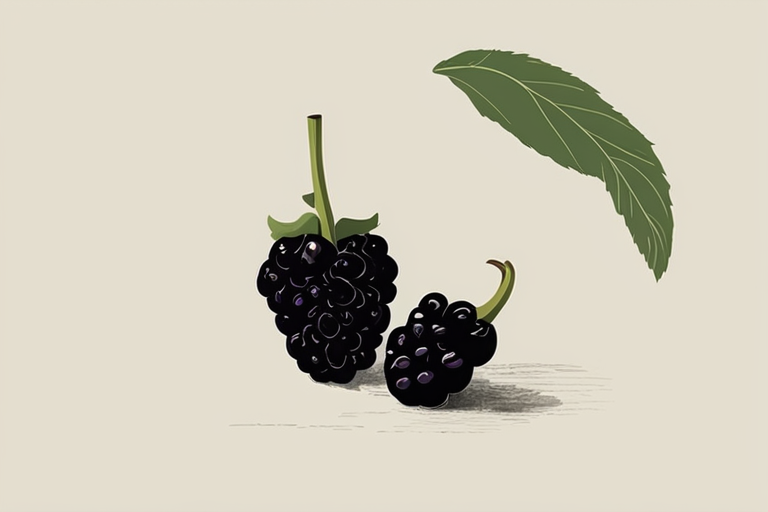
Signs that Black Mulberry Has Gone Bad
Get Your Free Food Safety Cheat Sheet
30 most common foods with instant answers. Print it and stick it on your fridge—completely free!
Signs that Black Mulberry Has Gone Bad
Black mulberries are delicious and nutritious fruits that are enjoyed by many. However, like all fruits, they can go bad if not stored properly. In this blog post, we will discuss the signs that black mulberries have gone bad and provide tips on how to store them to ensure they stay fresh for longer. (Black mulberry)
How to Identify Spoiled Black Mulberries
Visual Signs
- Mold: Mold is a common sign that black mulberries have gone bad. If you see fuzzy white, green, or black spots on the surface of the berries, it is best to discard them.
- Discoloration: Black mulberries should have a deep purple or black color when ripe. If you notice any unusual discoloration, such as brown or yellow spots, the berries may be spoiled.
- Wrinkled or Shriveled Skin: Fresh black mulberries should have smooth and plump skin. If the skin appears wrinkled or shriveled, it is a sign that the berries are past their prime.
Texture
- Soft or Mushy: When black mulberries start to spoil, they may become soft or mushy to the touch. Fresh mulberries should have a firm texture.
- Slimy Texture: If the berries feel slimy or sticky, it is a clear indication that they have started to deteriorate.
Smell
- Unpleasant Odor: Spoiled black mulberries may emit a sour, musty, or fermented odor. If the berries smell off or unpleasant, it is best to avoid consuming them.
Tips for Storing Black Mulberries
Proper storage is key to keeping black mulberries fresh for a longer period. Here are some tips to help you store your mulberries effectively:
- Refrigeration: Store black mulberries in the refrigerator to prolong their shelf life. Place them in a shallow container lined with paper towels to absorb excess moisture.
- Avoid Washing: Only wash black mulberries right before consuming them. Excess moisture can promote mold growth and cause the berries to spoil faster.
- Freezing: If you have an abundance of black mulberries, consider freezing them for future use. Spread the berries in a single layer on a baking sheet and freeze until solid. Transfer the frozen berries to a resealable bag or airtight container for long-term storage.
- Use Within a Few Days: Black mulberries are best consumed within a few days of purchase. Try to use them up quickly to enjoy them at their peak freshness.
Safety Precautions
When it comes to food safety, it is essential to follow proper guidelines to prevent foodborne illnesses. Here are some safety precautions to keep in mind when handling black mulberries:
- Wash Hands: Always wash your hands thoroughly before handling black mulberries to prevent contamination.
- Clean Cutting Boards and Utensils: Ensure that cutting boards, knives, and other utensils are clean and sanitized before preparing black mulberries.
- Check Expiry Dates: If purchasing packaged black mulberries, check the expiry date to ensure they are fresh and safe to consume.
- Store Away from Contaminants: Keep black mulberries away from raw meat, poultry, seafood, and other potential contaminants in the refrigerator to prevent cross-contamination.
Conclusion
In conclusion, being able to identify the signs that black mulberries have gone bad is essential for ensuring food safety and enjoying fresh, delicious fruit. By following the tips for storing black mulberries and practicing safety precautions, you can extend the shelf life of these nutritious berries and reduce the risk of foodborne illness. Remember to always trust your senses and discard any black mulberries that show signs of spoilage to protect your health and well-being. (Black mulberry)

Authoritative Food Safety References
These agencies and university labs inform every tip and health precaution we publish.
USDA FoodKeeper – Cold Storage Guidelines
Official refrigerator, freezer, and pantry timelines maintained by the U.S. Department of Agriculture.
Visit USDA FoodKeeperFDA Produce Safety Rule & Grower Guidance
Field-to-fridge handling practices that prevent contamination of fruits, vegetables, and leafy greens.
Visit FDA Produce SafetyCDC Foodborne Illness Prevention Hub
Surveillance-backed guidance on pathogens, symptoms, and steps to reduce foodborne illness risk.
Visit CDC Food SafetyUC Davis Postharvest Technology Center
University research detailing optimal storage atmospheres for produce after harvest.
Visit UC Davis PostharvestPenn State Extension – Home Food Preservation & Safety
Peer-reviewed extension bulletins on safe canning, chilling, and reheating practices.
Visit Penn State ExtensionCan I still eat black mulberries if they are slightly wrinkled?
How should I store black mulberries to keep them fresh longer?
Can I freeze black mulberries to preserve them?
Are there any food safety tips I should follow when handling black mulberries?
Get Your Free Food Safety Cheat Sheet
30 most common foods with instant answers. Print it and stick it on your fridge—completely free! Want more? Upgrade to the complete guide with 70+ foods.
Scan your food directly and get instant safety info using our AI-powered camera feature.